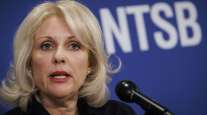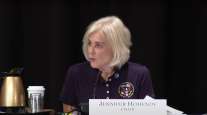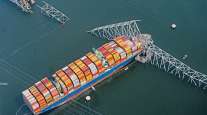Senior Reporter
NTSB Chair Jennifer Homendy Calls for a Shift in Safety Focus

[Stay on top of transportation news: Get TTNews in your inbox.]
U.S. highways could be as safe as the nation’s skies if road transportation embraced the “safe system approach” that helps the aviation industry annually report zero fatalities, the new National Transportation Safety Board leader said.
Jennifer Homendy, confirmed by the Senate last month as the new chair of the NTSB, said in a keynote speech to the Governors Highway Safety Association annual meeting in Denver on Sept. 13 that the current approach, which favors automobiles and only punishes drivers for crashes, is clearly not working.
“If we’re going to get to zero, we will have to do something different,” Homendy said. “The carnage on our roads has to stop. You know it, and I know it. That’s why we need to do one more big, important thing: zero traffic deaths. Some people say that is impossible. I’m here to tell you it is possible.”
.@NTSB Chair @JenniferHomendy discusses the current state of transportation safety, @NTSB’s highway safety priorities and opportunities for collaboration during the #GHSA2021 Opening General Session. pic.twitter.com/6illKLXk8z — GHSA (@GHSAHQ) September 13, 2021
Homendy pointed out that “nearly every year, there are zero major passenger airline crashes.”
She said the so-called “safe system” approach requires a shift in the way transportation leaders think about traffic safety.
“We spent decades planning, designing, building and operating our road system for the efficient movement of people and goods, rather than safety,” she said. “And we spent decades developing counter-measures and behavioral interventions that are targeted at individuals rather than the entire system.”
Take speeding, for instance. Homendy asked: Does the responsibility for speeding rest solely on the driver’s poor choice? Or does the system as a whole play a role in incentivizing that driver to speed?
“Did the road design encourage high speeds? How about ill-conceived federal guidance that leads to ever-increasing speeds limits in states? How about states that fail to give local authorities the ability to set lower speed limits, vehicle manufacturers that design vehicles that can exceed 100 mph, or that have no speed governors when we know in Europe that’s standard?”
Of course, there is still a need for enforcement of traffic laws, she said.
Homendy said the “safe system” approach is currently on the NTSB’s Most Wanted list of transportation improvements. The NTSB defines the safe system as one that addresses all aspects of traffic safety: road users, vehicles, speeds, roads and post-crash care.
“We must make better safety investments, from road treatments, vehicle design and collision-avoidance systems to strong traffic safety laws and robust education efforts to mitigate injury risks for all road users,” the NTSB list says.
Homendy, who has been on the NTSB board since 2018, spent 14 years as Democratic staff director for the House Transportation Subcommittee on railroads, pipelines and hazardous materials. She previously has held positions with the International Brotherhood of Teamsters, the AFL-CIO and the American Iron and Steel Institute.
Homendy said that Albert Einstein defined insanity as doing the same things over and over again, and expecting different results.
The Chair told traffic safety professionals to proceed with the mindset that road safety is a shared responsibility & implementing a Safe System will require everybody—not just traffic safety leaders—to come to the table to identify the best solutions and collaborate. #NTSBmwl pic.twitter.com/23UzSf0Wx7 — NTSB (@NTSB) September 13, 2021
“So today I’m calling on all transportation leaders from roadway designers to public health officials up to the governor, from vehicle manufacturers to transportation providers, from entire communities to safety advocates to embrace a new way, a new approach, a new vision for traffic safety — the ‘safe system’ approach,” Homendy said.
“We need to break down silos, and make sure everyone is at the table, and working together to identify the best solutions. That’s what aviation did. We can too.”
Road safety is a shared responsibility, and it will take everybody coming to the table, she added. “That means planners, designers, engineers, law enforcement, policymakers, public health officials, educators, vehicle manufacturers, insurers, rail and transit providers, can’t be forgotten.”
Homendy pointed to a 1962 iconic speech in Houston by President John F. Kennedy, a year after he told Congress about his administration’s plan to put a man on the moon. “We choose to go to the moon in this decade and do the other things, not because they are easy, but because they are hard,” she recited.
“We choose to save lives, not because it is easy, but because it is hard, and we care,” Homendy said.
Want more news? Listen to today's daily briefing below or go here for more info:




